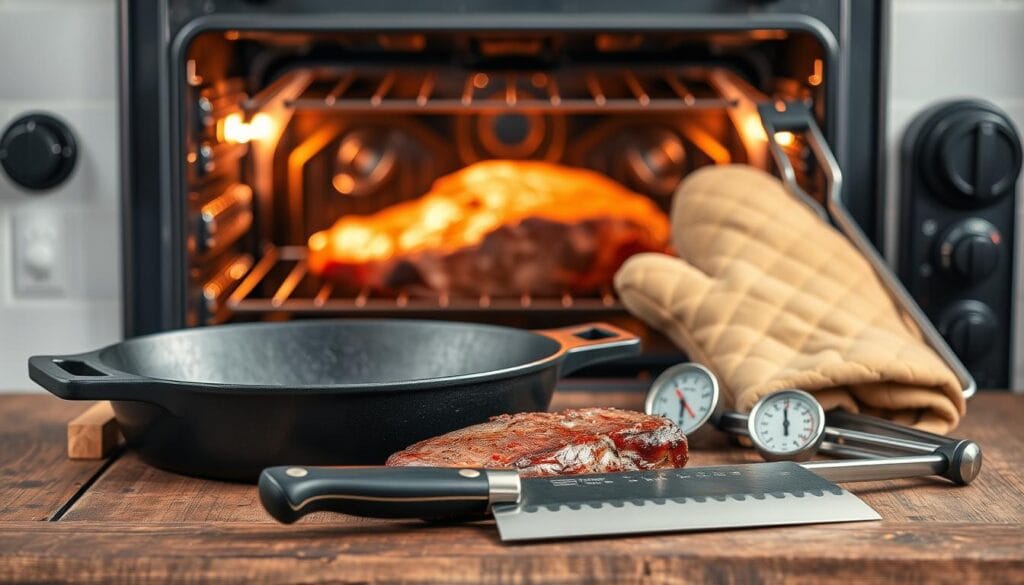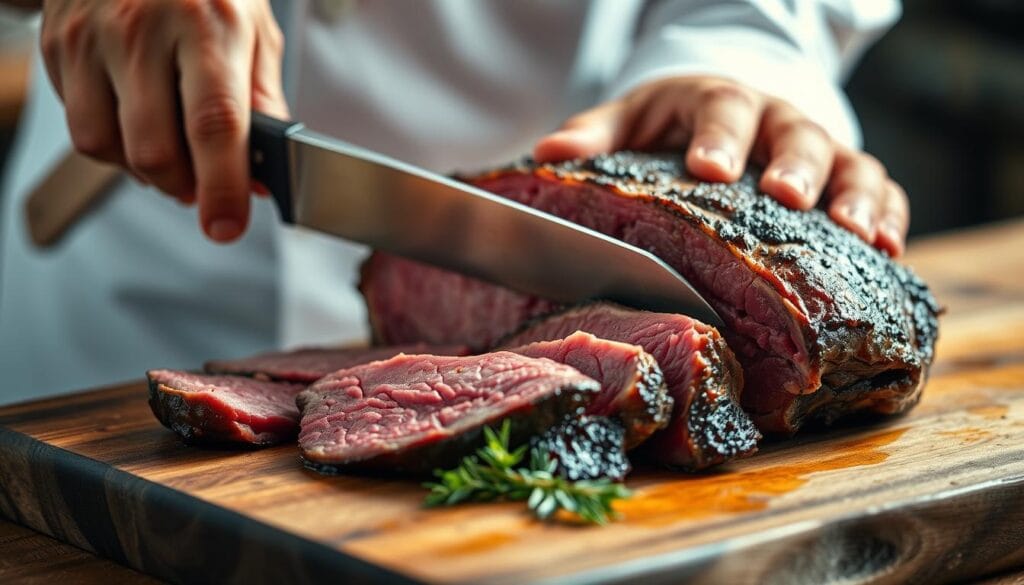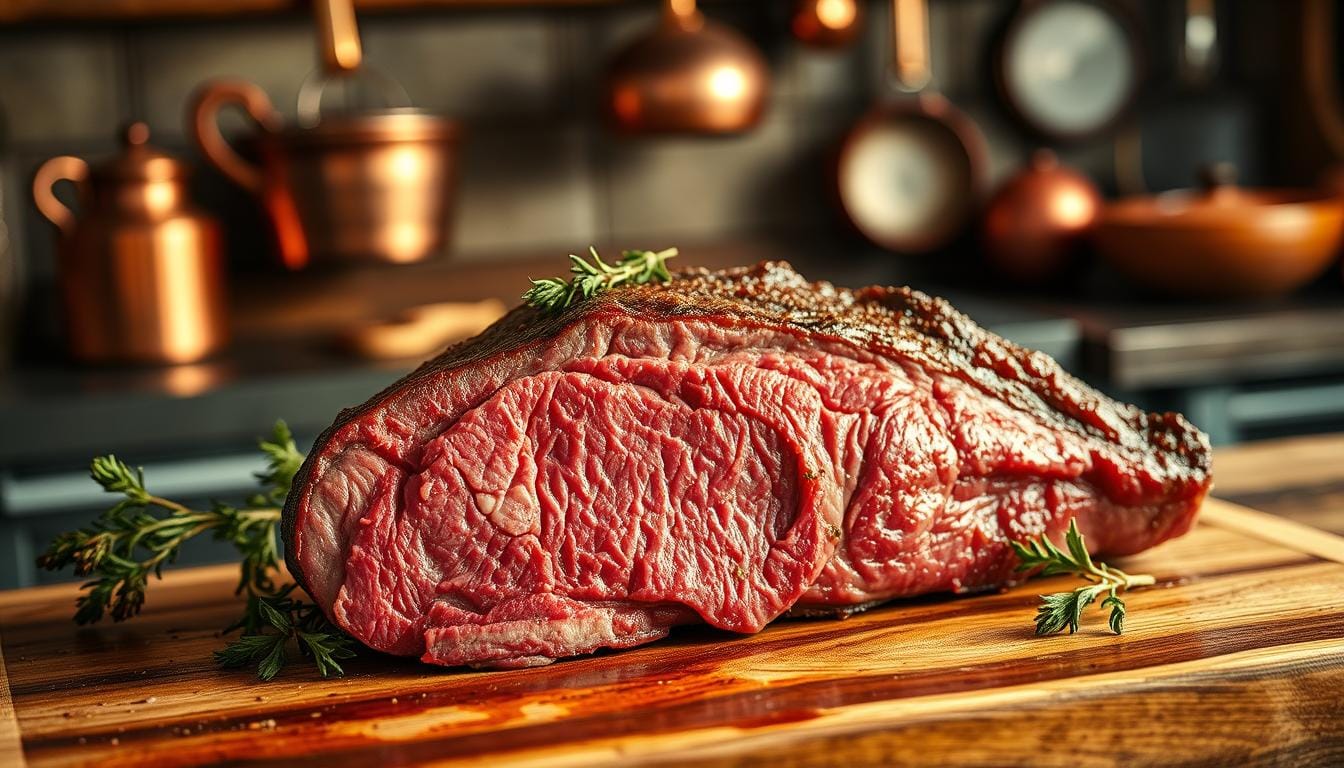Imagine a ribeye roast recipe that makes your kitchen smell like a fancy restaurant. The sizzling sound, the rich aroma of herbs, and the first tender bite – it’s more than a meal, it’s an experience.
Creating the perfect ribeye roast recipe is about more than just cooking meat. It’s about making a dish so good, everyone wants more. This guide will help you make a ribeye roast that’s truly amazing, whether you’re a pro or just starting out.
Knowing the right cooking time is key to a perfectly cooked ribeye roast. From picking the right cut to getting the temperature just right, every step is important. You’ll turn a simple dinner into a feast that will be your go-to dish.
This detailed guide will show you how to make a ribeye roast that’s juicy, full of flavor, and unforgettable. Let’s explore the art of making the ultimate roast. It will take your cooking to new heights and impress even the pickiest eaters.
Understanding the Perfect Ribeye Roast
Choosing the right ribeye roast is an art. It combines quality, cut, and cooking skills. Your journey to a delicious roast starts with knowing what makes it special.
What Makes a Prime Cut Special
USDA Prime beef is the top quality. Its beautiful fat marbling is key. This marbling adds:
- Rich, intense flavor
- Exceptional tenderness
- Juicy, melt-in-your-mouth texture
Bone-in vs Boneless Options
You have two main choices: bone-in and boneless. Knowing the difference helps you pick the right one for your cooking.
| Bone-in Roast | Boneless Roast |
|---|---|
| Provides extra flavor | Easier to carve |
| More even cooking | More uniform shape |
| Natural meat support | Convenient preparation |
Choosing the Right Size
The size of your roast depends on how many guests you have. A 5-pound roast serves about 8 people. Plan for 1 pound of meat per person for everyone to have enough.
Pro tip: Choose a roast with consistent marbling and a bright red color. This ensures a memorable dining experience.
Essential Equipment for Cooking Success
Getting the perfect ribeye roast recipe is more than just using great meat. The right kitchen tools are key to achieving top-notch results. You need the right equipment to control the ribeye roast temperature and make a delicious meal.

Here are the essential tools you’ll need for your ribeye roast recipe:
- Roasting Pan with Rack: Ensures even heat distribution and allows air circulation around the meat
- Digital Meat Thermometer: Critical for monitoring internal temperature precisely
- Sharp Carving Knife: Guarantees clean, professional-looking slices
- Kitchen Twine: Helps truss the roast for uniform cooking
- Heavy-duty Aluminum Foil: Perfect for tenting and resting the meat
When picking your roasting pan, go for a sturdy, high-sided one that can handle your ribeye roast’s weight. A rack inside the pan helps the meat cook evenly. It prevents it from sitting in its own juices. The digital meat thermometer is your secret to perfect ribeye roast temperature. It takes away the guesswork, ensuring great results every time.
Invest in quality tools, and you’ll take your home cooking to the next level. You’ll make a professional-grade ribeye roast that will wow your family and friends.
The Ultimate Ribeye Roast Recipe
Making the perfect ribeye roast recipe needs precision, quality ingredients, and careful prep. Your journey to a delicious roast starts with knowing the key parts and techniques. These steps turn a simple cut of meat into a memorable meal.
Ingredient List
- 1 whole ribeye roast (4-6 pounds)
- 1/2 cup kosher salt
- 4 tablespoons tri-color peppercorns
- 6 tablespoons olive oil
- 1/2 cup minced garlic
- 3 sprigs fresh rosemary
- 3 sprigs fresh thyme
Garlic Herb Butter Preparation
Make a tasty garlic herb butter by mixing softened butter with minced herbs, crushed garlic, and a bit of salt. This ribeye roast seasoning boosts the meat’s flavor, making it rich and aromatic. It brings out the roast’s natural taste.
Step-by-Step Instructions
- Take the ribeye roast out of the fridge 1 hour before cooking to warm up
- Heat the oven to 425°F for the initial sear
- Pat the roast dry with paper towels
- Season it well with kosher salt and ground peppercorns
- Sear the roast in a hot skillet for 3-4 minutes on each side
- Spread garlic herb butter all over the roast’s surface
- Put it in a roasting pan and cook at 350°F
- Check the internal temperature with a meat thermometer:
- Rare: 125°F
- Medium-rare: 135°F
- Medium: 145°F
- Let the roast rest for 30 minutes before carving
Your ribeye roast recipe will feed about 8 people, offering a great taste experience for each. The secret to a perfect roast is monitoring the temperature and letting it rest well.
Temperature Guide for Perfect Doneness
Getting the perfect ribeye roast temperature is an art. It needs precision and knowledge. Your choice of doneness affects the meat’s flavor, tenderness, and taste. Knowing the temperature ranges helps you make a delicious ribeye roast every time.
When cooking a ribeye roast, the internal temperature is key. Different doneness levels match specific temperature ranges:
- Rare: 120-125°F
- Medium Rare: 130-135°F
- Medium: 140-145°F
- Medium Well: 145-150°F
- Well Done: 160°F and above
The cooking time for a ribeye roast depends on the size and your desired doneness. A meat thermometer is essential for accurate temperature checks. Remember, take the roast out of the oven 5-8°F before your target temperature to account for carryover cooking.
Food safety is crucial. The USDA says beef should be at least 145°F, with a three-minute rest. Always check the roast’s temperature, even more so when serving vulnerable groups.
Be patient. Let your ribeye roast rest after cooking. This step helps juices spread and completes the cooking. Resting ensures a juicy, tender, and perfectly cooked roast that will wow your guests.
Mastering the Art of Seasoning
Turning a simple ribeye roast into a masterpiece starts with seasoning. The right herbs, spices, and techniques can make your recipe stand out. They bring out the meat’s natural flavors.
Creating the perfect seasoning for your ribeye roast is key. It’s about finding the right balance of flavors. This can take your roast from good to amazing.
Creating the Perfect Herb Crust
The secret to a great herb crust is choosing the right ingredients. Here are some essential elements for your ribeye roast:
- Fresh herbs like rosemary, thyme, and sage
- Coarse kosher salt
- Freshly ground black pepper
- Minced garlic
- Olive oil or softened butter
Seasoning Tips and Techniques
Here are some expert tips for seasoning your ribeye roast:
- Pat the meat dry before adding seasonings
- Put on seasonings at least 1 hour before cooking
- Press herbs and spices into the meat’s surface
- Let the roast come to room temperature before cooking
Remember, a little seasoning goes a long way. You want to enhance the beef’s flavor, not hide it. A well-thought-out mix of herbs and spices will make a delicious crust. This crust seals in the meat’s juices, giving you a memorable meal.
Proper Resting and Carving Techniques

Learning how to rest and carve your ribeye roast is key to a great meal. After cooking, your roast needs to relax and let its juices spread out. Experts say to let it rest for 15-30 minutes for the best tenderness and juiciness.
While it rests, cover it loosely with aluminum foil. This keeps it warm and lets moisture escape. It’s important – it stops the meat from losing juices when you carve it.
- Rest the roast for 15-30 minutes after cooking
- Tent with foil to keep warm
- Place on a cutting board with a lip to catch drippings
When carving, use a sharp long-bladed carving knife. Look at the meat’s grain and cut against it. This makes the meat tender.
Here are some tips for carving:
- Place the roast with the bone facing you
- Cut parallel to the bone, creating even slices
- Aim for uniform thickness around 1/4 to 1/2 inch
- Serve immediately for the best flavor and texture
Be patient. Hurrying can ruin your hard work on the ribeye roast.
Wine Pairing Suggestions
Finding the perfect wine can make your ribeye roast even better. The right wine brings out the meat’s rich flavors, making your meal unforgettable.
Red Wine Recommendations
For ribeye roast, full-bodied red wines are the best choice. They match the meat’s strong taste perfectly.
- Cabernet Sauvignon: The classic choice for prime cuts of beef
- Malbec: Offers bold flavors that match the meat’s intensity
- Pinot Noir: Provides a lighter yet sophisticated pairing
- Syrah: Brings rich, spicy undertones to your meal
Alternative Beverage Pairings
Not everyone likes red wine with their ribeye roast. Here are some great alternatives:
| Beverage Type | Flavor Profile | Pairing Recommendation |
|---|---|---|
| Chardonnay | Full-bodied white | Excellent for less traditional pairings |
| Dry Rosé | Light and crisp | Great for those seeking a lighter option |
| Craft Beer | Rich and complex | Ideal for beer enthusiasts |
Experts say to match the wine’s weight with the meat’s richness. Your ribeye roast needs a wine that enhances its deep, savory taste while offering a nice contrast.
Delectable Side Dish Options and Leftover Ideas
Your ribeye roast deserves side dishes that make the meal special. Try ranch potatoes and roasted carrots with honey herb butter for a boost. A mashed potato casserole with bacon and crispy onions or cheddar biscuits are great too.
For veggies, sautéed green beans with pomegranate seeds or maple bacon Brussels sprouts are tasty. They add color and exciting flavors to your dish. Creamed spinach with nutmeg and black pepper is a luxurious touch that guests will love.
Leftover ribeye roast opens up many creative options. Use it for gourmet sandwiches, a hearty Caesar salad, or a quick hash with root veggies. This way, you can enjoy it in different meals, making sure nothing is wasted.
Pro tip: Keep leftover ribeye roast in airtight containers for 3-4 days. This keeps it fresh and safe to eat. With these ideas, your ribeye roast becomes a versatile dish that offers many meals.


1 thought on “Delicious Ribeye Roast Recipe: A Juicy Masterpiece”